The herbaceous perennial orchid paphiopedilum, or the lady's slipper, or papiopedilum, is a member of the Orchid family. Under natural conditions, such a plant can be found in Sumatra, New Guinea, China, India, Kalimantan, the Philippines, Malaysia, Thailand and China. The scientific name of such a plant was formed from the toponym Paphos (the mythical homeland of the goddess Venus), as well as the word that translates as “slipper, sandal”. Pafiopedilum literally translated means "slipper from Paphos", this is due to the fact that the flowers of such an orchid have a shape similar to a woman's shoe.
For the first time this plant was discovered by Nathaniel Wallich in 1816, while in 1820 it blossomed for the first time in culture, more precisely, in the Liverpool Botanical Garden. Already at the beginning of the 21st century, experts gave a description of about seventy species of papiopedilum orchid. Moreover, some of these species are very popular among flower growers. However, not only species, but also varietal orchids, as well as artificial and natural hybrids (grexes), are cultivated in indoor conditions.
Content
- 1 Brief description of cultivation
- 2 Features of the papiopedilum orchid
- 3 Caring for papiopedilum at home
- 4 Reproduction methods
- 5 Flowering papiopedilum
- 6 Diseases and pests of papiopedilum
- 7 Pafiopedilum varieties with photos and names
- 7.1 Paphiopedilum apricot (Paphiopedilum armeniacum)
- 7.2 Paphiopedilum appleton (Paphiopedilum appletonianum)
- 7.3 Paphiopedilum bearded (Paphiopedilum barbatum)
- 7.4 Paphiopedilum rough-haired (Paphiopedilum villosum)
- 7.5 Paphiopedilum insigne
- 7.6 Paphiopedilum lawrenceanum
- 7.7 Paphiopedilum hairy (Paphiopedilum hirsutissimum)
- 7.8 Paphiopedilum adorable (Paphiopedilum venustum)
- 7.9 Paphiopedilum delenatii
- 7.10 Paphiopedilum small-flowered (Paphiopedilum micranthum)
- 7.11 Snow paphiopedilum (Paphiopedilum niveum)
- 7.12 Paphiopedilum pretty (Paphiopedilum bellatulum)
Brief description of cultivation
- Bloom... For the first time, the bush blooms at 6-7 years of growth. Duration of flowering - up to 6 months.
- Illumination... The optimal daylight hours are 12 hours. Small-flowered and variegated varieties feel best in light shade, while multi-flowered and green-leaved ones - a large amount of diffused bright light is needed.
- Temperature regime... It depends on the variety, but most often in the cold season - 17-19 degrees, and in the spring-summer period - 20-23 degrees. Remember that such an orchid needs a daily temperature difference: at night the room should be 3-4 degrees colder than during the day.
- Watering... During the growing season, the substrate in the pot is moistened systematically, immediately after the top layer dries. And during the dormant period, the bush should be watered only when the substrate is completely dry.
- Air humidity... It should be elevated.Remember that the higher the air temperature in the room, the higher its humidity should be.
- Fertilizer... They are fed during the growing season: fertilizers are applied to the substrate once every 2 weeks, while organic matter and mineral complexes are alternately used in a half dosage. During the dormant period, you cannot feed the bush.
- Dormant period... Not pronounced. When the plant has faded, it should be allowed to rest. To do this, it is rearranged in a cool place, not fed and rarely watered. 6 weeks is the minimum resting time for an orchid.
- Transfer... They spend it in the spring. While the bush is young, it is transplanted every year, and more mature specimens - once every 2-3 years.
- Reproduction... By dividing the bush.
- Diseases... Various fungal diseases, most often rot.
- Pests... Spider mite, scale insect and mealybug.
Features of the papiopedilum orchid
The papiopedilum orchid has a well-developed root system. The length of the sheet plates can vary from 5 to 60 centimeters, and their shape is broad-linear, belt-like or oblong. The leaves are brought together in a two-way socket. They have a solid green color, but sometimes there is a marble pattern of a darker shade on the leaf plates.
The peduncles can reach a height of 4-60 centimeters. As a rule, single flowers are formed on them. However, there are species and varieties in which 2–30 large flowers are formed, alternately located on one flower arrow. As a rule, the flower has a wide upper sail of a rich color. The sail can be shaped like a canopy and cover the reproductive organs and the inside of the lip, preventing water from entering them. There are 3 anthers, of which only 2 are fertile. And one anther is modified into a thyroid body, which covers the reproductive organs of the flower.
Most of the species of this orchid are lithophytes, which means that they prefer to grow on rocky ground or on rock. There are 3 species that are semi-epiphytes (they can grow in the ground and parasitize on trees), and 2 more species are lithophytes (they grow exclusively on trees). Also, among the various types of papiopedilum, there are calcephiles, which prefer to grow on chalk and limestone soil.
Caring for papiopedilum at home
The papiopedilum orchid is a rather capricious and demanding plant for growing conditions. However, if you are not afraid of difficulties, then just study all the preferences of this plant and find out how to properly care for it. This will be enough to decorate your home with such an unusual flower.
Illumination
The optimal lighting of such an orchid is directly related to the species or variety:
- bright diffused lighting is necessary for green-leaved plants, as well as those in which a large number of flowers are formed on the peduncle (windows of southern, eastern and western orientation are preferred);
- on the northern window, in shading, few-flowered and variegated species and varieties prefer to grow.
The duration of daylight hours for the papiopedilum orchid is 12 hours. In this regard, in winter, when the days are short, the bushes need mandatory supplementary lighting.
Temperature regime
All types and varieties of this plant are divided into four groups according to the degree of thermophilicity:
- variegated bushes feel good at an air temperature of 18 degrees - in winter and 23 degrees - in summer;
- orchids, the foliage of which is green and narrow, need an air temperature 2 degrees lower compared to variegated;
- bushes that bloom continuously grow well in summer at a temperature of 22 degrees, and in winter - 19 degrees;
- plants with broad green foliage are kept at 17 degrees in winter and 20 degrees in summer.
Despite the fact that the difference between temperatures is not very noticeable, however, in order for the bush to develop and grow within normal limits, it is very important. Also remember that the orchid needs a mandatory temperature difference during the day: the difference between temperatures during the day and at night should be 3-4 degrees.
Watering pafiopedilum
Watering should be systematic. In this case, the substrate in the pot is moistened only after the surface of the substrate dries out. During the growing season, watering should be more frequent and they are carried out immediately after a slight drying of the upper layer of the substrate. Shortly before the beginning of the formation of buds, the substrate in the pot is moistened only when it dries out to a decent depth. The fact is that a slight drought stimulates flowering.
When the plant is at rest, watering is carried out only when the substrate is completely dry. And after young shoots appear on the bush, they begin to moisten it with the same frequency as in summer. Particular attention should be paid to watering during the growth of young rosettes, at which time the bush needs more moisture.
You can water papiopedilum only with well-settled (at least 3 days) or filtered water, the temperature of which should be close to room temperature. If water droplets get on the leaf plates, then after they dry, specks will remain in this place. To prevent this, it is recommended to use bottom watering. For this, the pot, along with the flowers, is immersed in a deep container of water. In order for the bark not to float away, it is first pressed with a load, and you can also put a mesh on the substrate.
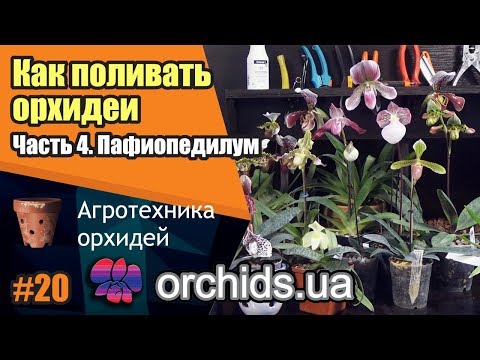

Watch this video on YouTube
Air humidity
Remember that the warmer the room, the higher the humidity level should be. As a rule, the flower feels fine at a humidity level of 40-50%. However, if the room is very hot, then the humidity will have to be increased to 60-70%.
Top dressing
During the growing season, this orchid needs mandatory feeding, and complex mineral fertilizers and organic matter should be used in turn. You need to feed the bushes once every 15 days, while the dosage of fertilizer is used 2 times less than indicated on the packaging by the manufacturer. Do not apply too much fertilizer to the substrate, as this can cause the plant to become sick. During flowering or dormancy, all feeding is stopped.
Paphiopedilum transplant
While the bush is young, its transplant is carried out regularly once a year in the spring. Adult bushes are transplanted only when there is a need for it (on average, once every 2 or 3 years). As a rule, the transplant of a grown orchid is carried out if its roots do not fit in the pot or rot has appeared on them, and even if it suffers from a previous disease.
Particular attention should be paid to the choice of the pot. Better if it is made of plastic or clay (not glazed from the inside). The soil mixture should be light and loose, neutral or slightly acidic. If you wish, you can buy a ready-made earthen mixture in a specialized store, and you can also prepare it yourself: take 1 part of peat and charcoal each, and another 5 parts of the tree bark of coniferous crops. You can also use a substrate consisting of conifer bark, foam, perlite (retains moisture), crushed sphagnum and limestone (5: 1: 1: 1: 1). Pay attention to the preparation of the bark: it should be thoroughly rinsed and placed in a container of water for two days. During this time, she will have time to absorb the right amount of moisture. Remove the bark from the water and rinse it again. Only then can it be connected to other components.
Make a good drainage layer at the bottom of the pot, which should be about 20 mm thick. For this, you can use expanded clay or fine gravel.After that, the drainage is covered with a layer of polystyrene or coarse bark. Then the orchid is transplanted by transshipment, then the roots are covered with bark of the middle fraction, and then the pot is filled with a mixture of the bark of the fine fraction with other components.
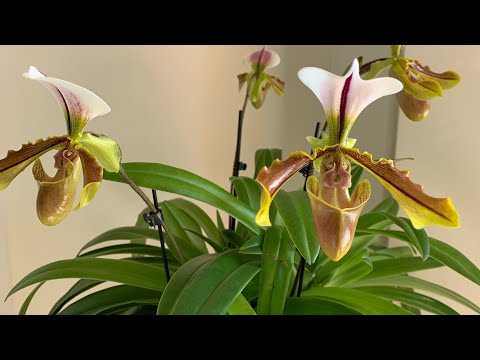

Watch this video on YouTube
Reproduction methods
The papiopedilum orchid growing in indoor conditions, as a rule, is propagated by division. The division of the bush is carried out together with a transplant in the spring. Please note that there should be at least 3 shoots on each section cut from the parent bush.
Dividing the orchid bush step by step:
- well moisten the substrate in the pot, then remove the bush from it;
- carefully remove the remaining substrate from the root system;
- using a pre-sterilized sharp instrument, cut out dried roots or decayed areas, and it is imperative to capture a part of healthy tissue;
- the plant is divided into the required number of parts;
- they process the places of fractures, cuts, and also wounds, for this they use activated or charcoal, crushed into powder;
- the delenki must be planted in separate pots, at the bottom of which a drainage layer must be made.
During the first 15 days, the planted bushes are kept warm (from 21 to 22 degrees), while all watering is prohibited. However, using a fine sprayer, it is necessary to regularly humidify the air around the bush. Once the bushes are rooted, they are given the same care as adult plants.
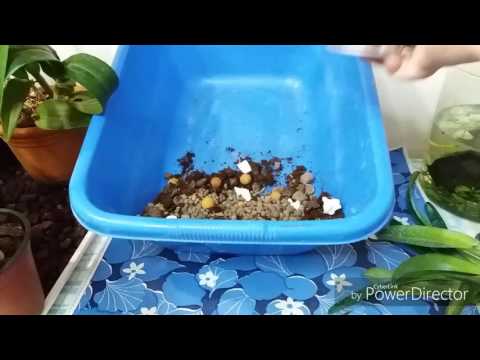

Watch this video on YouTube
Flowering papiopedilum
Leaving during flowering
If the papiopedilum orchid is properly looked after and provided with optimal conditions for growth, then it will bloom every year, and even at the same time. It is from the young socket formed during the current season that the appearance of a peduncle is observed. The fact that the bush is ready to bloom can be understood by the following sign: at the point of growth, a leaf plate will form, which, after it grows to a certain size, will stop developing. However, the formation of the signal leaf plate does not mean that the orchid will necessarily begin to bloom. But if you provided her with proper care, then the shortened plate will become denser over time and form a bud. Once this happens, do not rearrange the plant, and it is better not to touch it at all. The fact is that if the bush is ready for flowering, then this means that it is quite satisfied with the microclimate in which it is located, and its rearrangement can only ruin everything. Remember that each of the rosettes can bloom only once.
Post-flowering care
Once flowering is over, the plant is given a good rest so that it can recuperate by the beginning of the growing season. To do this, the bush is rearranged to a cooler place (from 15 to 20 degrees), watering should become more rare, while fertilizers are not applied to the substrate at all. Despite the fact that the papiopedilum will be at rest, a kidney will form near the old outlet. It is from her that a young rosette and a peduncle will grow in the next season.
As soon as a young sprout appears, the bush should be provided with the temperature regime that is typical for it during the growing season. They also gradually return to the usual irrigation regime, and they also begin to feed the bush.
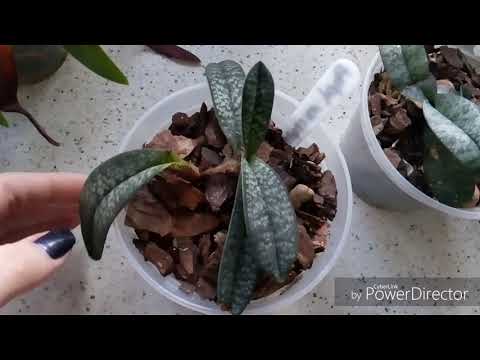

Watch this video on YouTube
Diseases and pests of papiopedilum
If the room has excessively high humidity and rather cool, then this can cause the development of a fungal disease on the papiopedilum orchids. The affected bush should be sprayed with a fungicide solution. In this case, the plant must be provided with optimal conditions for growth, otherwise the problem will return again.
Pafiopedilum can be home to pests such as mealybugs, scale insects and spider mites. As a rule, scale insects and scale insects settle on the seamy surface of the leaf plate. If pests are found, they are removed from the plant with a cotton swab dipped in a solution of high concentration soap or in alcohol. After that, the bush is thoroughly washed under a warm shower. However, if the measures taken are ineffective, then the orchid will need to be treated with an insecticidal agent.
Measures to combat spider mites are completely different. The fact is that they are so small that it is almost impossible to see them with the naked eye. You can understand that ticks have settled on a flower by the pale yellow spots in the puncture sites, as well as by a thin cobweb on the foliage. If a pest is found, the bush is washed under a warm shower, wait until it dries well, and then spray it with a solution of Karbofos, Aktellik or Fitoverma. Since these pesticides are very toxic, it is recommended to carry out the treatment in a well-ventilated area or outdoors.
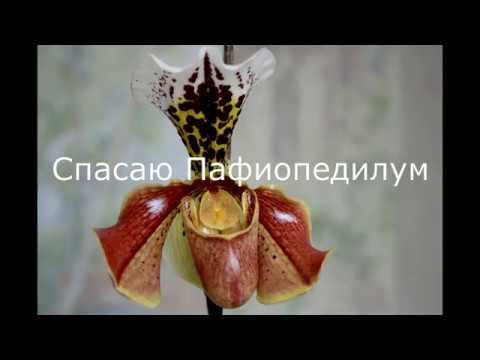

Watch this video on YouTube
Pafiopedilum varieties with photos and names
Below will be described those varieties of papiopedilum orchids that are most popular with flower growers.
Paphiopedilum apricot (Paphiopedilum armeniacum)
This species comes from the mountainous regions of China. The length of the green leaf plates is about 15 centimeters, on the front surface there is a marble pattern of a dark green hue, while on the seamy side there is a dark red bit pattern. On the surface of the green peduncle there is pubescence and dots of purple color. Flowering begins in the first half of December and ends in early March. The flowers reach about 11 centimeters in diameter, they are painted in a deep yellow color. Their lip is rounded, and the petals are wavy along the edge.
Paphiopedilum appleton (Paphiopedilum appletonianum)
The homeland of this shade-loving species is Thailand, Vietnam, China, Cambodia and Laos. However, he prefers to grow on stumps and stones that are covered with moss. Dense, narrow and long leaf plates are colored deep green, and in some cases there are marble stains on their surface. In spring, flowers bloom on the bush, reaching about 10 centimeters across, petals of a violet-lilac color are elongated. They are decorated with green specks.
Paphiopedilum bearded (Paphiopedilum barbatum)
This type is very popular with flower growers. Already in 1869, the first hybrid, Harrisianum, was obtained. The foliage is about 20 centimeters long, with a marble pattern on the green surface. The species blooms in the spring. Each flower has a greenish middle at the top petal, and the upper edge is white, while the entire surface is lined with purple stripes. The side petals are about the same color, but they are more faded. The lilac-red lip of the flower is rather large.
Paphiopedilum rough-haired (Paphiopedilum villosum)
Indonesia and India are considered the birthplace of this plant. In such a vigorous species, the length of the peduncles can reach up to 30 centimeters. Flowering continues from autumn to spring. The brownish-green upper petal of large flowers has a white border. Other petals are ocher with a pale brown tint. In this case, the lip can be pale brown or reddish, and its surface is speckled with thin veins.
Paphiopedilum insigne
In nature, the species can be found in the Himalayas. The length of the thin sheet plates is about 30 centimeters. The bush blooms in September, and fades at the end of winter. There are many varieties of this species with flowers of very different colors. However, in the most spectacular variety, the side petals are painted mainly in a coffee shade, while the middle of the upper petal is yellow with specks of a brown hue, and a wide white border runs along the edge.
Paphiopedilum lawrenceanum
The homeland of this plant is the island of Borneo. It differs from other species in its unpretentious care and less demanding on growing conditions. The length of the greenish leaf plates is about 15 centimeters, there are stains on their surface.The middle of the pointed upper petal is green and there are stripes on it, while closer to the edge there is a smooth transition of color to a pale red hue. The glossy lip is dark red, with many specks of brown on the edge of the side petals.
Paphiopedilum hairy (Paphiopedilum hirsutissimum)
In natural conditions, the plant can be found in Thailand, India, Laos and Vietnam. The bush is decorated with narrow leaf plates, while a special protective cover covers the base of the peduncle. In the last winter weeks, large flowers open on the peduncle, the entire surface of which is covered with pubescence. At the very beginning of flowering, the edge of the upper petal is even, and when the flower begins to fade, it becomes wavy. Its edge is greenish, and the middle is brown. Lateral bright purple petals are smooth along the edge, while in the middle they are gathered in a ruff.
Paphiopedilum adorable (Paphiopedilum venustum)
The species is found in India and Nepal, while it prefers to grow in wooded mountains. Elongated elliptical sheet plates are about 50 mm wide. They are painted in a greenish-gray shade with a dark green marble pattern on their surface. The length of the peduncle can be more than 20 centimeters. The species has eight varieties, and all of them differ in color of flowers. In the most spectacular variety, the middle of the side petals is green or yellow, while as it approaches the wavy edge, the color changes to burgundy with dots of a dark shade along the edges. On the surface of the greenish upper petal, which has a triangular shape, there are clear even stripes. The lip is light burgundy and has many chaotically located stripes. Its seamy surface has a pale yellow color.
Paphiopedilum delenatii
This compact species is native to Vietnam. The length of its elongated lanceolate leaf plates is about 10 centimeters, and their width is up to 4 centimeters. On the seamy surface of the leaves there is a marble pattern consisting of specks of dark and light green shades, while the seamy side has a purple tint. The length of the peduncles is about 25 centimeters, 1 or 2 flowers bloom on them, which reach about 80 mm in diameter. The lip and petals are white, while their surface is strewn with pale purple merging specks.
Paphiopedilum small-flowered (Paphiopedilum micranthum)
In natural conditions, the plant can be found at an altitude of 300-1600 meters above sea level in southern China and northern Vietnam. Despite the name of the species, its fragrant flowers are rather large: they reach 7–10 centimeters in diameter, while their pinkish lip is larger than that of all other species. Small velvety leaf plates are decorated with a marble pattern.
Snow paphiopedilum (Paphiopedilum niveum)
The homeland of such a plant is the Malay Peninsula, Kalimantan and Burma. His stem is almost invisible due to the many green leaf plates, decorated with spots, and their seamy surface is purple-lilac. Flowering is observed in the summer. One flower arrow reveals 1–2 flowers, reaching about 70 mm in diameter, on the surface of all petals there are pink specks.
Paphiopedilum pretty (Paphiopedilum bellatulum)
The species is found in Thailand, China and Burma, and it prefers to grow on mossy slopes and rocks. Its dark green foliage is decorated with a greenish speck, and in the middle it has a longitudinal strip of a darker green hue. In mid-spring, 2 white flowers open on the peduncle, which reach about 10 centimeters in diameter. Their petals are decorated with randomly spaced small spots of a dark crimson hue.
In addition to those species and varieties that are described above, such as papiopedilum Godefroy and Rothschild are popular with flower growers. In addition, hybrids of this plant are quite common, in particular, American papiopedilum, or rather, its variety, papiopedilum Vinicolor Maudi.


Watch this video on YouTube


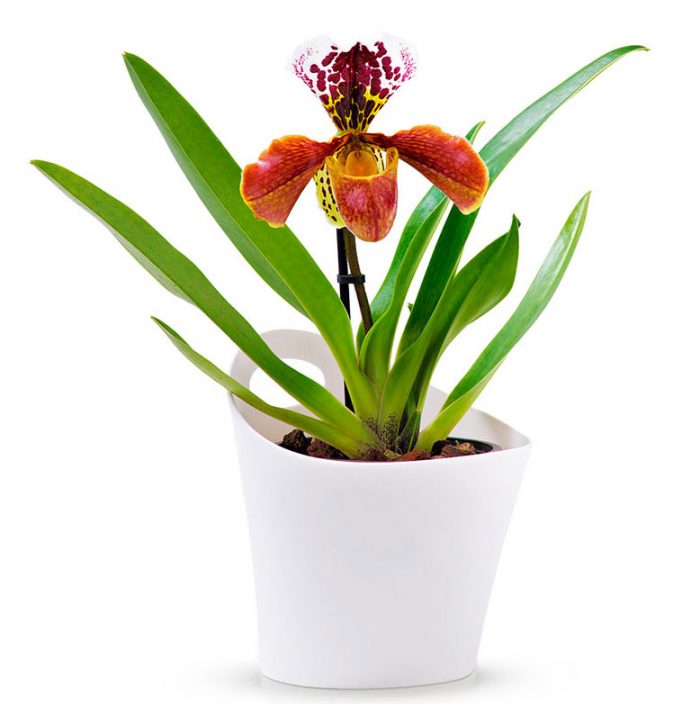
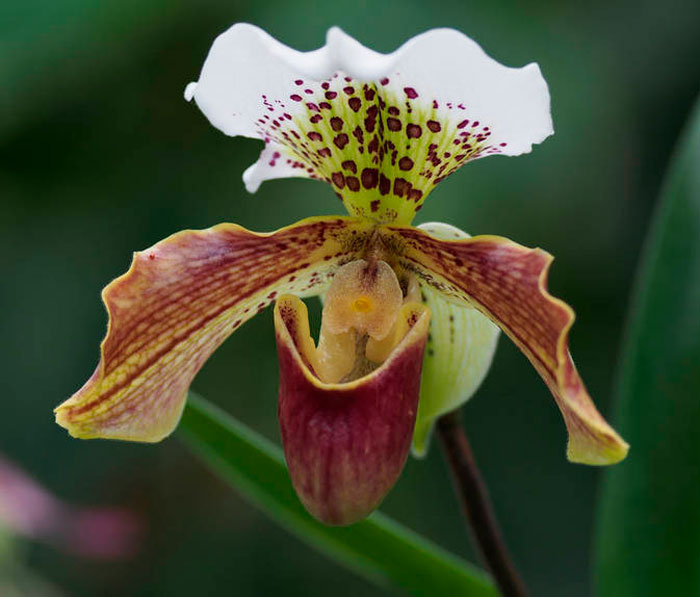
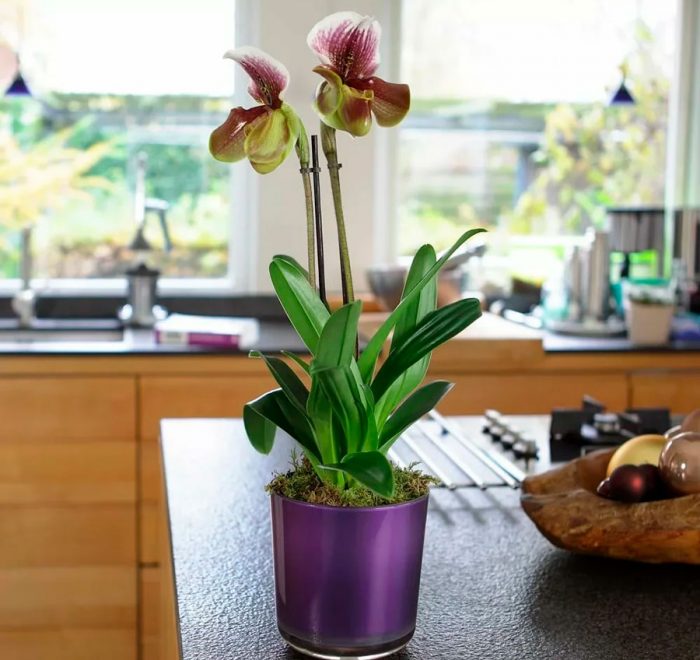






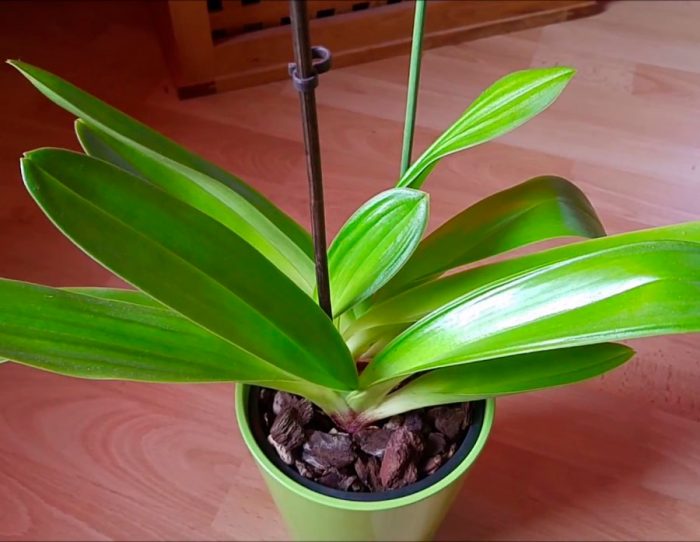

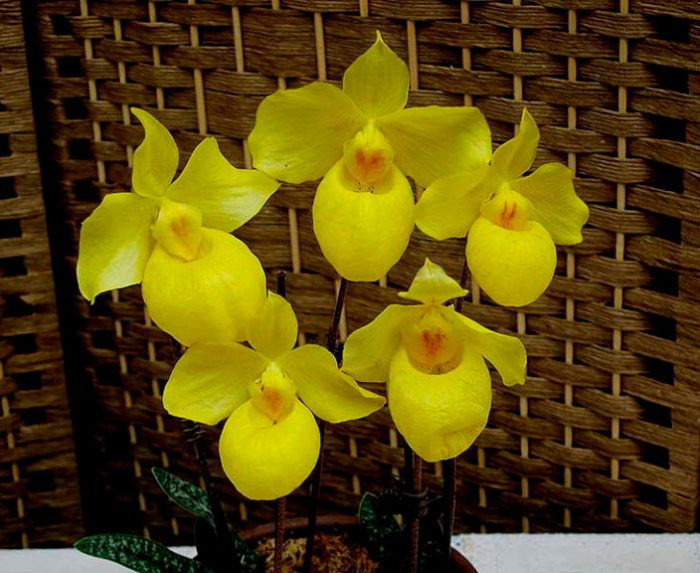

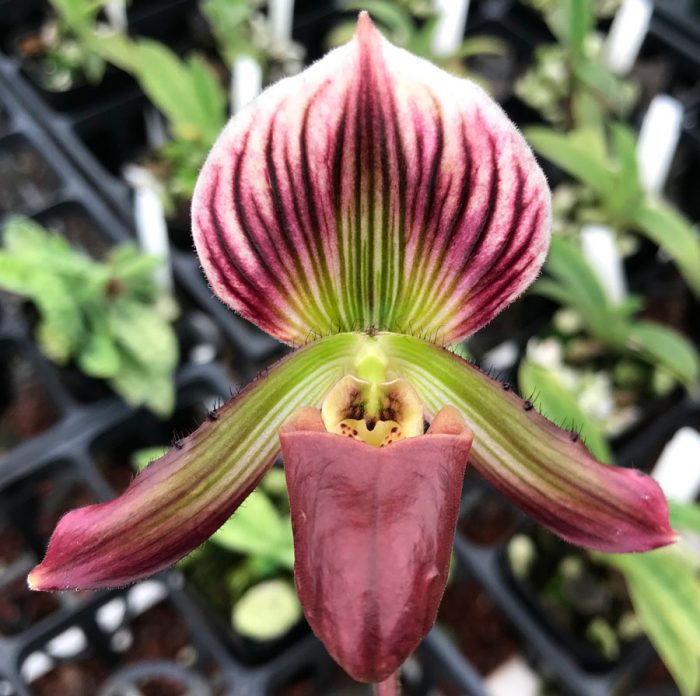
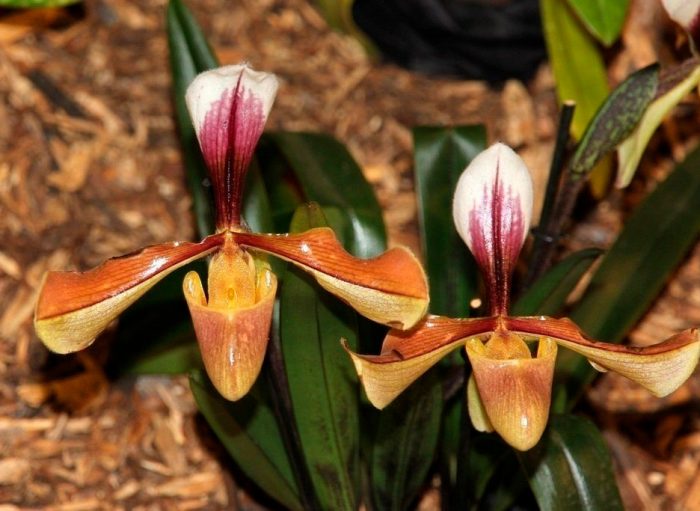
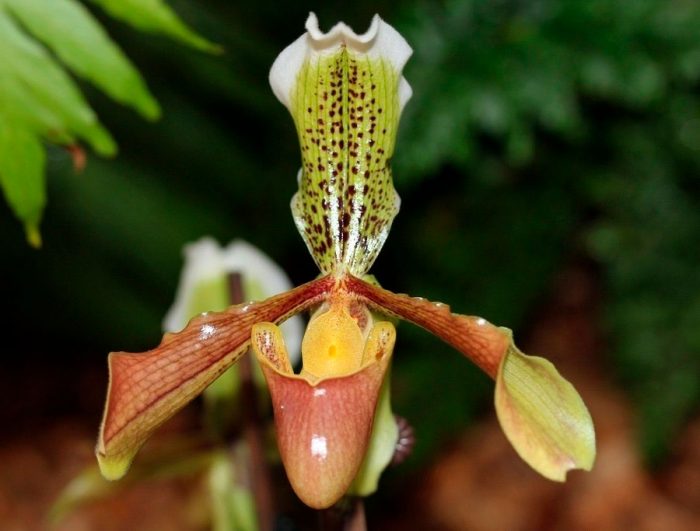
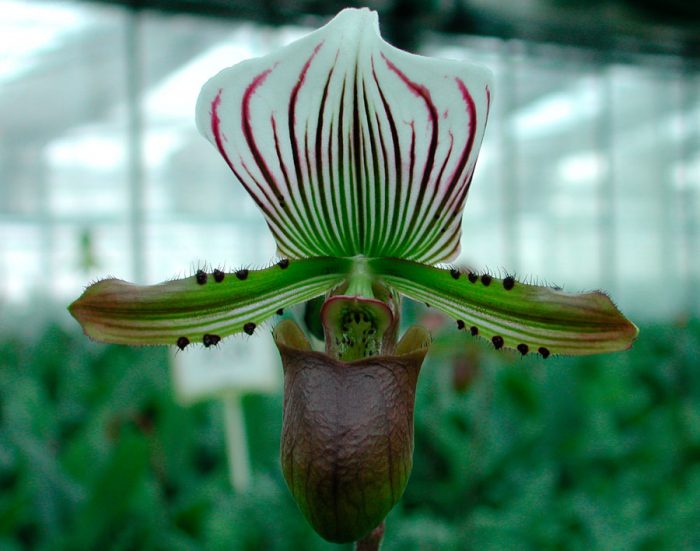

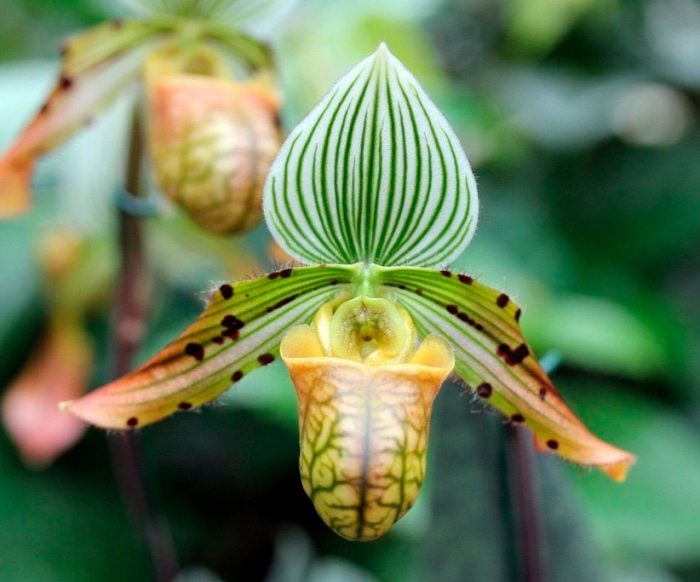


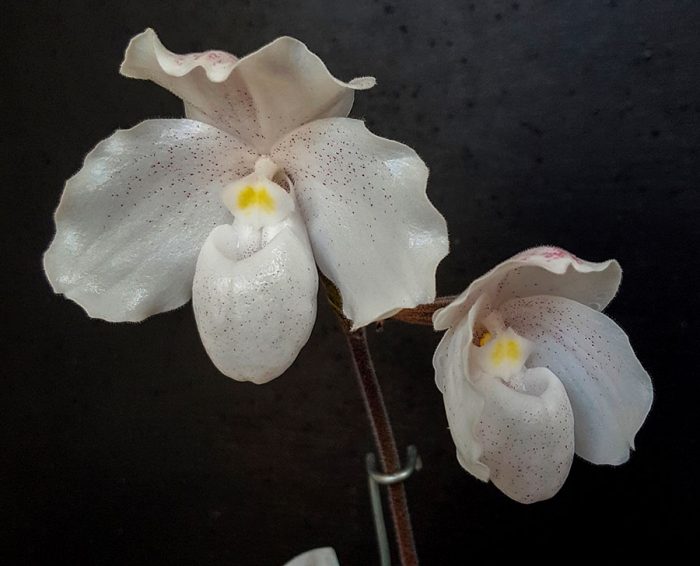
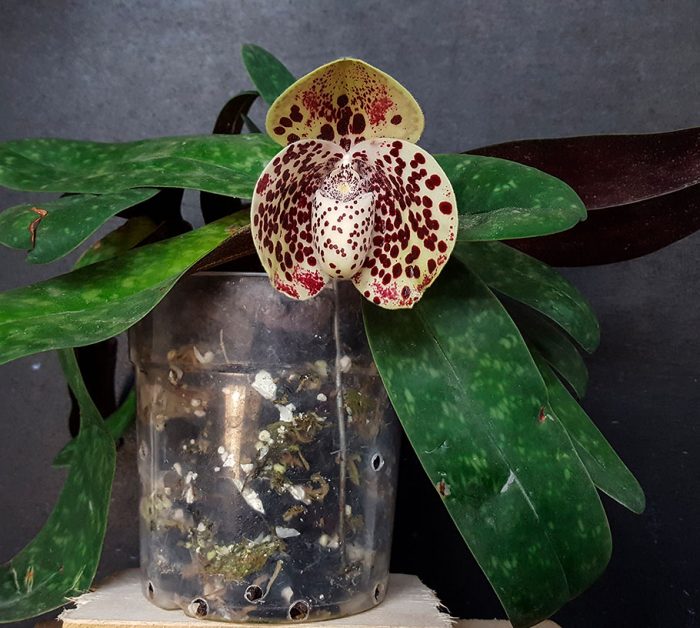




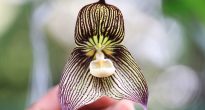


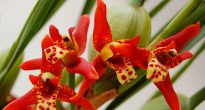
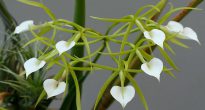

I bought at a discount 2e one without a flower is barely alive the other with a flower but it looked like frostbitten and on the second day I had to cut both alive and the second even gave an increase And I learned about another rarity Agapetes is also very similar to heather now and I have one we will grow and wait for spring than they will please us